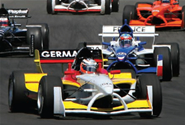Red, Orange, Green … Go!

The roar of engines, the smell of fuel and the noise of the crowd – it’s a petrol head’s dream. International motorsport now has a worthy home in New Zealand thanks to an upgrade to Taupo Motorsport Park, as Charlotte Stapleton reports.
Today, Taupo Motorsport Park houses an international race track for cars and motorbikes, a test track facility, an international drag strip and a pit lane area. The facility’s business park houses related industries, such as vehicle modifications, driver training and engine construction.
David Steele, Managing Director of MIT Development Ltd which was set up to develop and manage the Park, says it is now considered the best facility of its type in Australasia. It provides “true multi-use configurations, allowing our track hire to be maximised whilst providing a specialist race configuration for exciting spectator racing.”
Back in 2002, the facility was a 1.3-kilometre club track with a small pit area, but Chris Abbott and Ian Maskell had big plans. The two motorsport enthusiasts had a vision to extend and develop the track into a commercially sustainable motorsport facility. Their review identified that attracting major motorsport events and establishing other commercial activities on the site could bring $43 to $45 million into the Taupo district – $19 million in economic benefits for a significant international event alone.
Connell Wagner Ltd was engaged to develop the conceptual design, prepare preliminary drawings of the circuit and safety features, and put together initial costs. “In the early stages plenty of ideas were thrashed around,” says project team leader Matt Flannery, but the prime concerns were the Fédération Internationale de l’Automobile (FIA) circuit design and safety standards guidelines, and achieving a development cost of no more than $12 million.
